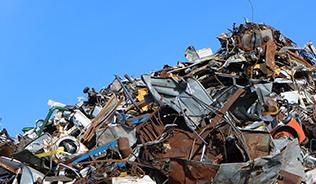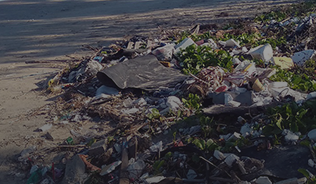environmental SCIENTIST | Air Quality - should we have achieved more? | April 2013
Don’t drink the water and don’t breathe the air!”
I can still remember the brutal satire of the Tom Lehrer song ‘Pollution’1 in the 1960s. I guess that was what got me interested in the environment. But lots of things have come together to make the Clean Air in London campaign what it is today. From a personal perspective, the best part has been creating something, delivering results and working with such a large, diverse and wonderful network of supporters and others.
The story began over 20 years ago when I jumped at an opportunity from my employer to attend a 12-month programme with Common Purpose (a leadership training organisation) which introduced me to nearly a dozen different aspects of society, including health, housing, transport and the environment. It was inspiring. A few years later, I joined my local residents’ association. Before long I was helping the association and my work mentor, who was by then a near neighbour, run a campaign against the City of Westminster (a London borough) that ended up in the High Court with a finding in our favour. However, I learned that there is little point trying to persuade politicians to do things they do not want and do not have to do. I decided it would be easier to ask them to comply with public health laws.
Perhaps by chance or to try another route, the same mentor suggested air pollution was bad in our area and encouraged me to set up and chair a new Transport and Environment Committee for the Knightsbridge Association (KA; a local organisation in Westminster) in 2006. Before long, and wanting to start at the top, the new Committee had written to the then-Mayor of London Ken Livingstone, urging a bolder low-emission zone. Next thing, the Committee was responding on behalf of the KA to the Department for Environment Food and Rural Affairs (Defra) consultation on a new Air Quality Strategy with support from every official amenity society in the City of Westminster. Each of these letters was laboriously printed and posted until I realised the power of email.
The launch of the campaign
It was beginning to become administratively cumbersome to encourage others to support each committee letter. That was when Dr Charles Tannock, a Conservative MEP, suggested I set up a campaign that people could support. This culminated in February 2007 in the launch of the cross-party Campaign for Clean Air in London with a group of Honorary Founder Supporters who are still involved in the campaign. Ken Livingstone wrote personally in support of the aims of the campaign.
By then the campaign had a blog on the BBC Action Network to publish its letters and announcements, and I was starting to be interviewed by the press and television. Perhaps annoyingly for the Government, I had then figured out, largely by trial and error, the BBC search engine algorithm and the campaign was appearing top in searches on the BBC’s global website. Ned Temko of The Observer had also written the first big press story, ‘Chelsea choked by its tractors’2.
Most of 2006 and 2007 was spent lobbying on a proposed new Air Quality Directive that would replace several existing directives dating back to 1996 and 1999. At one stage, it seemed the process was logjammed. So the campaign wrote to the then European Commissioner for the Environment, Stavros Dimas, copying in MEPs and many others, urging the European Commission, the European Parliament and the Council of Ministers to accept the highest common denominator – in health and environmental terms – proposed by each of them. Combined, later in the process, with an insistence that three ‘red lines’ had to be met if a new Directive was to be better than the previous legislation, that is more or less where the new Directive ended up. Writing those letters and emails may have been Clean Air in London’s most valuable contribution to air quality and public health.
The campaign principles
Underpinning the campaign has been a vision. It was obvious the campaign needed to be Londonwide, health-based and cross-party if it was to get established and remove hurdles to acceptance. Several other principles emerged:
- The London Matrix: a table with two columns labelled ‘Air pollution’ and ‘Greenhouse gases’ (or ‘Sustainability’) and two rows labelled 'London’ (or any other city) and ‘Rest of the world’. The vision is to comply with air quality laws and health standards for air pollution in London and show how wider air pollution and sustainability issues can be tackled successfully everywhere through a mixture of political will, technology and behavioural change. This is a powerful tool in discussions with policy makers to put the issue in context and communicate a positive vision.
- The London Principle: accept a one-per-cent increase in greenhouse gases (e.g. carbon dioxide) if a measure can achieve a 10 per cent reduction in air pollution (e.g. oxides of nitrogen) and vice versa (provided air pollution laws are complied with in full). The ratio is not precise or fixed but the principle allows, for the first time, practical trade-offs between climate and air quality issues with diesel exhaust being the classic example.
- The London Circles: measures to tackle transport typically fall into one of two overlapping circles. Emission measures, like the low-emission zone, which tackle primarily emissions at source and may reduce congestion; and congestion measures, like road-user pricing, that tackle congestion and may reduce emissions. Each measure usually offers secondary benefits for the other.
From a personal perspective, I have learned that air pollution problems are best tackled at their source rather than through offsetting (by tree planting or creating green walls, for example), and it is not so much a question – in air pollution terms – of how big a vehicle is but rather how much fuel it burns in total. More recently, I have begun to understand the danger of scientific research being used (by others) to manufacture uncertainty. Also the danger that policy-makers and legacy industries use specious arguments to defend the status quo, e.g. we must not reduce sulphur emissions from shipping because they have a short-term cooling effect in the atmosphere! We need to keep thinking holistically and remember that emissions are the problem and that we need to get on with reducing them; Janez Potočnik, current European Commissioner for the Environment, wisely calls it ‘resource efficiency’.
The vital elements
A campaign needs a compelling vision backed by data, pressure and support (which is similar to the approach recommended by human resources professionals to change the personal behaviour of employees). More particularly, a campaign needs:
- Governance. Clean Air in London, for example, is now a legal entity and is answerable primarily to its Honorary Founder Supporters, sponsors and clients. It is also important to carry your supporters with you. Earlier the campaign operated under the auspices of the KA.
- Content. What are the big issues? Who is responsible for what and when are the milestones? Are there consultations to reply to? Are there cover-ups? Are there shocking failures or omissions? Use Google alerts to warn you about news or developments on the web. What are the top solutions? For example, Clean Air in London proposed 45 measures in its manifesto for the Mayoral and London Assembly elections in 2012. and at the top of the list was political leadership.
- Prioritise. Don’t be a ‘busy fool’. Identify the objectives, focus on mission-critical milestones and do not be distracted or broaden your remit just because it might seem more fun. Spend 80 per cent of your time doing ‘moving ahead’ things and 20 per cent on maintenance. Focus on return on effort and outputs. Achieve something important every single day, in one place, for years. Measure your performance, e.g. number of media articles including a mention of your organisation. Never give up.
- Marketing and communication. No one is under any obligation to listen to you or read what you write. Make it easy for people to access your content and share it. Set up a website with as much bandwidth as you can afford. Apart from anything else, it saves you looking for things and having to email everything to people. Repeat, again and again, your most important messages, e.g. the World Health Organisation has classified diesel exhaust as carcinogenic for humans. Your first foray on the internet can be frightening, so go at your own pace and take basic precautions, but remember there is nothing more powerful for campaigners.
- Legal pressure. Research the legal constraints and insist they are complied with in full. Make the most of access to environmental information laws which are narrower but much more powerful than freedom of information laws, especially when enquiries relate to emissions to the environment. Clean Air in London has taken the Government to the Court of Appeal, with pro-bono support from Friends of the Earth’s Rights and Justice Centre and two excellent barristers, Gerry Facenna and Laura Elizabeth John. We lost the case but won numerous concessions from the Government that are now enshrined in law. A new challenge might achieve more.
- Empower others. Clean Air in London writes its letters and publishes key resources so that, as far as possible, others can tailor them to their own circumstances. The campaign has also increased its productivity by publishing guides that help others and allow you to say ‘Please read [it], then call me back’. There is a call to action, ‘10 steps for Clean Air in London’. Clean Air in London is also celebrating its first Clean Air in London Awards to recognise a wider circle of contributors.
- Be constructive, positive and upbeat. Your campaign has a vision to save the world, e.g. by using The London Matrix. Always be ready to propose solutions and try to end on a positive note. Don’t get bogged down by negativism or distractions, about European fines, for example, as they are necessary but final sanctions, like jail.
- Celebrate and enjoy your successes.
Working with the media
The important role of the media deserves a special mention. Media professionals have a very demanding occupation. The best and almost all are incredibly rigorous. Occasional mistakes are inevitable because they operate under near-impossible deadlines. If they contact you, you must respond immediately. You could offer or ask to send campaign quotes by email. Be willing to give robust quotes but weigh your potential liability. Build reciprocal relationships: suggest ideas to reliable media contacts. Bear in mind that you can spend days or weeks without any success, despite even thinking you have the best story in the world, then ‘all hell breaks loose’ and everyone wants to speak to you. Remember that the media is often fobbed off and managed by a large organisation’s media office, prevented from speaking to decision-makers, so direct access to campaigners is valuable to them.
Each media channel has different characteristics. Online can reach many people, is there forever (more or less) and can be corrected, if wrong. Everyone likes seeing something in the paper. Radio is often live and allows slightly longer comment. Television is perhaps the most powerful medium but you only get a sound bite and it is usually recorded and therefore edited. Remember a sound bite is roughly one sentence, not a headline. It can take me up to a day beforehand to distill a complex issue and myriad facts into one sentence and make notes of other points to answer or offer. Then, of course, you have to be lucky to be included! Do not make the mistake of thinking the television or radio can afford to let you ramble on.
Social media has a vital role to play too. It builds real relationships with a vast number of potential contacts and it is cheap. It is ideal for campaigners and often used by the media to source ideas and identify trends. Facebook is better for longer items. Twitter is fabulous for offering small inputs for big outputs and immediacy. Make sure that you use hashtags, lists, searches and people’s usernames: no one can follow their timeline once they are following more than 20 people! Ask questions: some followers asked Clean Air in London to tweet shorter messages (to allow others to add comments, make it easier to retweet and do less to help others, i.e. ‘spoonfeeding’ some followers). The power of Twitter is shown by people often referring to the campaign by its username, CleanAirLondon, (because Twitter does not allow space for ‘in’).
Why is air quality still bad?
With all these weapons at our disposal, why is something not being done about air pollution now it has been identified as the biggest public health risk after smoking? Why does the public not know about it? The answer to both questions is that successive Governments have not understood the health evidence or wanted to be asked what they are doing about air pollution or wanted to take action to deal with it (e.g. banning the oldest diesel vehicles from cities as Germany has done in over 45 cities). Scientists have only discovered in the last 10 years or so that the health impacts of long-term exposure to dangerous and invisible airborne particles dwarf those from short-term exposure to visible air pollution as we saw during the Great London Smog of 1952. Scientists are as certain now about these risks as they are of those from smoking.
Air Quality Ministers have sometimes displayed their ignorance and been reshuffled within weeks. But it is worse than that. In CAL’s view, the current Government is still failing to warn people and may be misleading them with statistics such as: “air pollution has declined significantly in recent decades”; air quality is “good across 99% of the UK”; and “air pollution still reduces life expectancy by an average of six months” (if averaged over 60 million people alive at the moment).
When asked about legal breaches, the government says it is concerned and has plans in place to reduce air pollution. Of course, Governments have omitted to mention that scientists have only known about the longer-term health impacts in the last decade or so. No wonder that the general public does not understand the importance of this issue.
What next?
The European Commission has named 2013 the Year of Air. The number of organisations actively campaigning on air pollution has mushroomed and media interest is rising exponentially. So far this year media interest is running two or three times that of last year, which was itself a record year. We need continuity and the further tightening of health and legal protections from new EU and UK legislation.
In my view, the solution lies in building public understanding of the dangers of air pollution, enforcement and tightening of existing laws, new legislation on sources of pollution.
Clean Air in London has had many successes in the last seven years. Together, we might just ‘save the world’ in the next seven!
Simon Birkett founded the cross-party Campaign for Clean Air in London in 2006. In 2009, Simon accused the previous British Government of one of the biggest public health failings or ‘cover-ups’ in modern history for not publishing an estimate for the number of deaths attributable to long-term exposure to dangerous airborne particles.
The campaign won the City of London’s inaugural Sustainable City Award for outstanding contributions to improving air quality. Simon is Founder and Director of Clean Air in London.
- Lehrer, T. (1965) ‘Pollution’. Reprise Records, Burbank, CA.
- Temko, C. (2006) Chelsea choked by its tractors, The Observer, 20 August. www.guardian.co.uk/news/2006/aug/20/transportintheuk.travelsenvironmenta....





